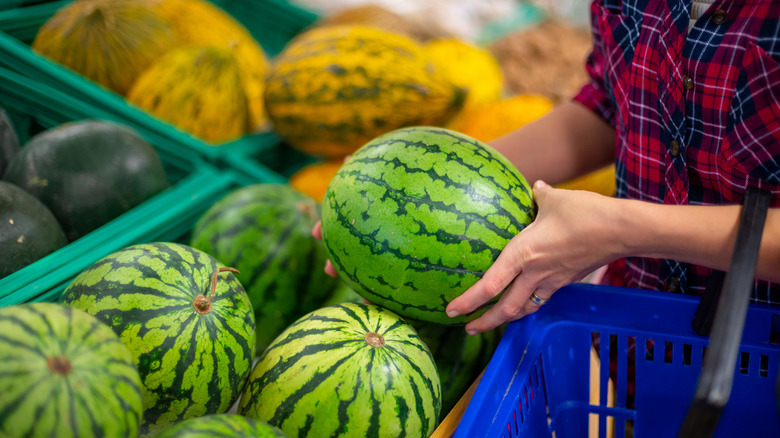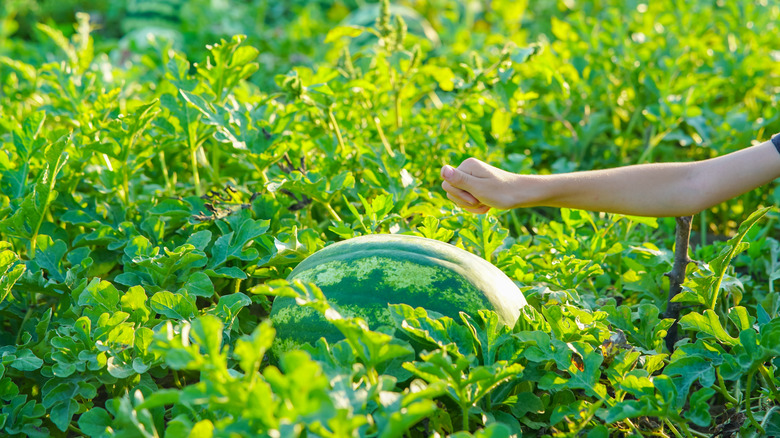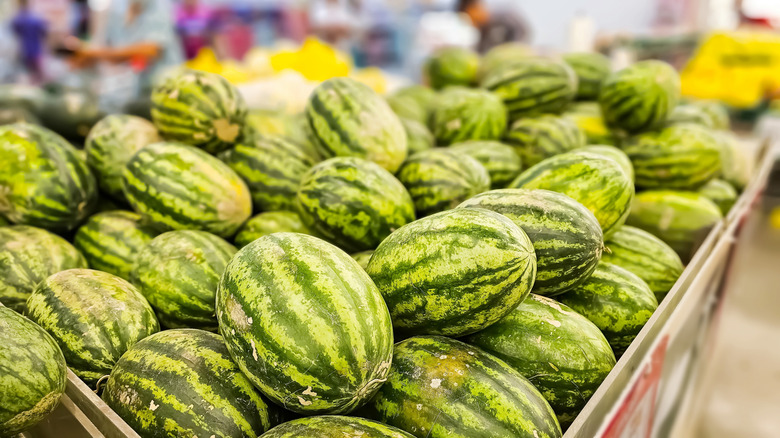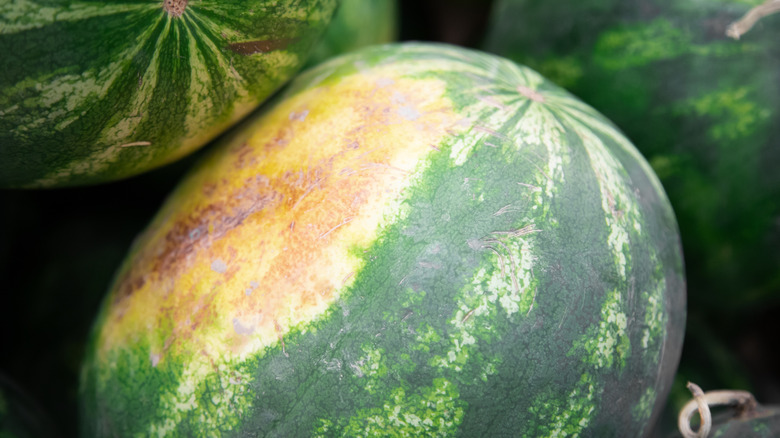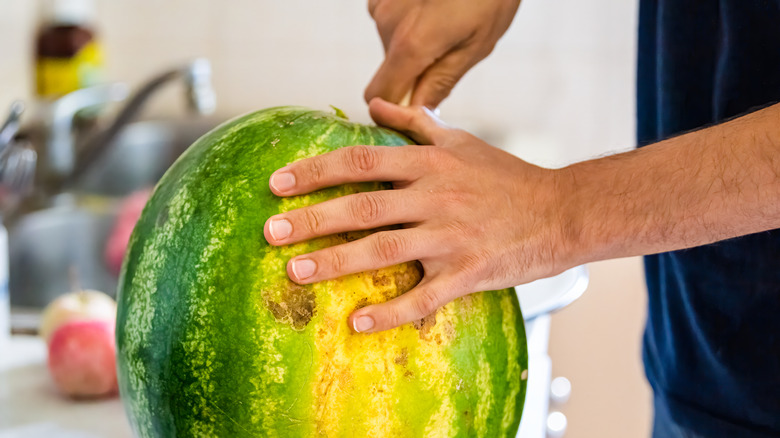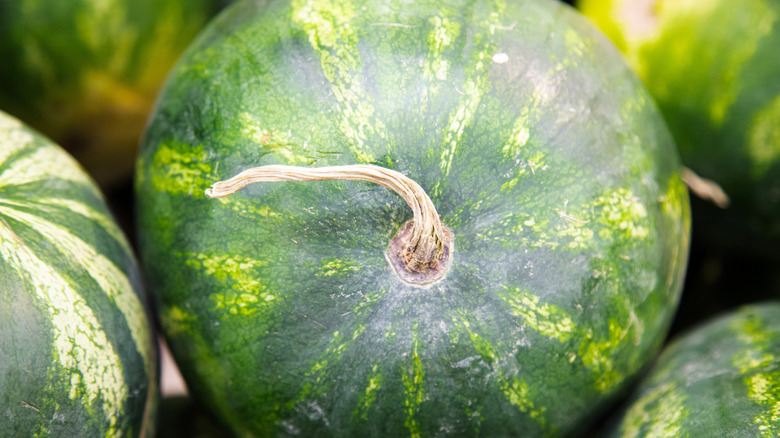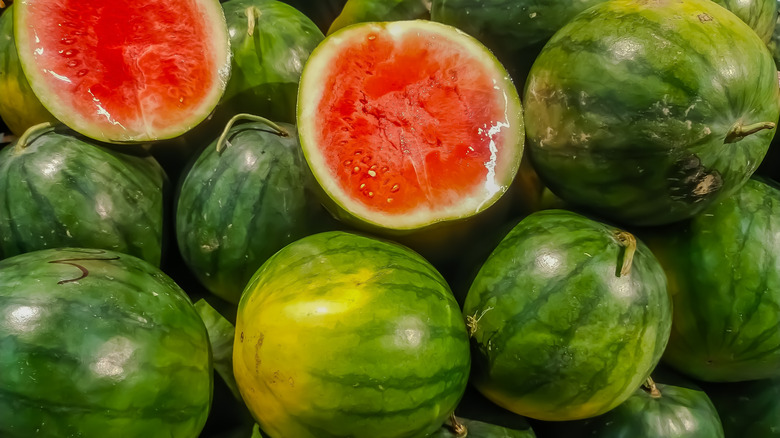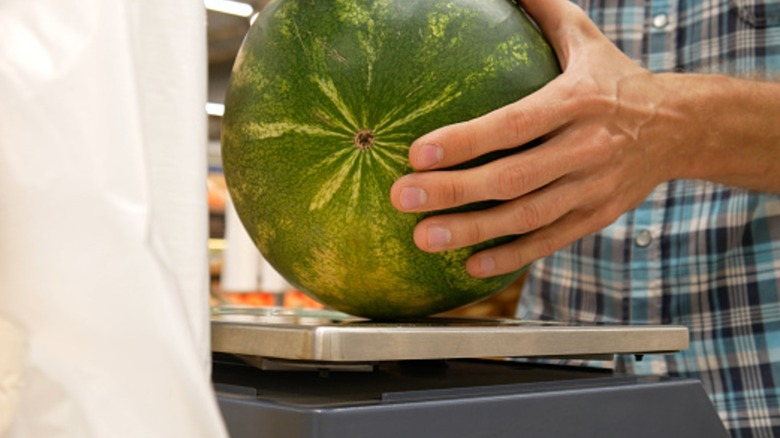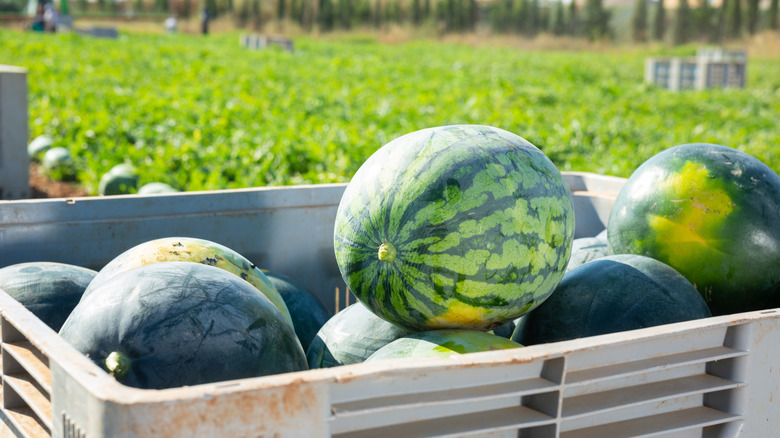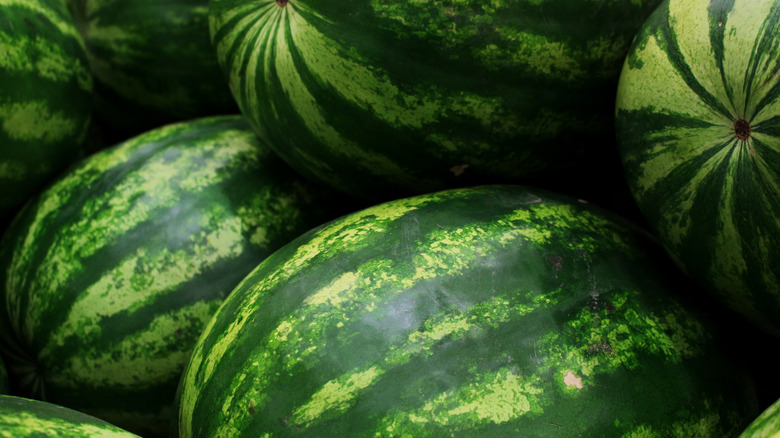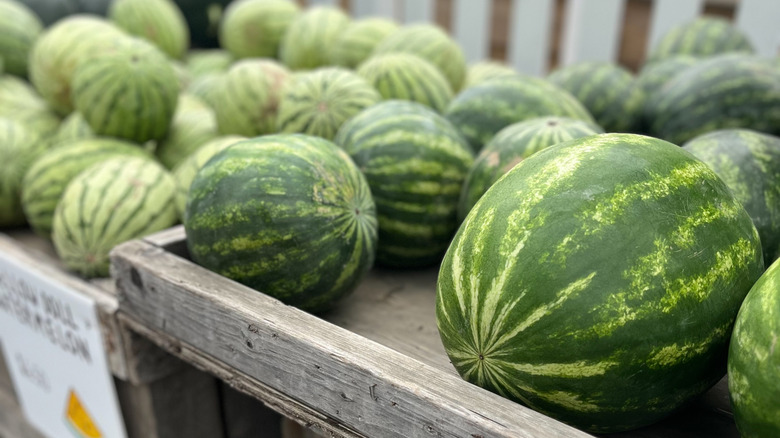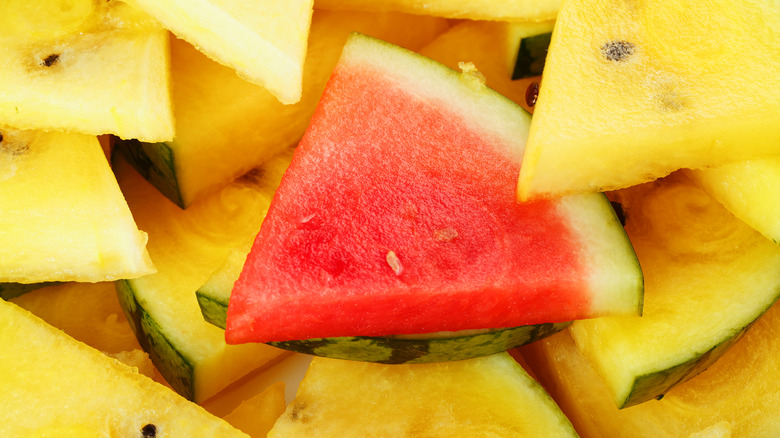14 Mistakes Everyone Makes When Buying Watermelon At The Store
If you've purchased (or just eaten) your fair share of watermelon, then you are likely well aware that two different melons, purchased on the same day at the same store, can be wildly different. If you pick a near-perfect watermelon, you get a sweet, juicy, tasty treat that tastes like the very essence of summer. If you pick a poor watermelon, you get a bland, less-than-ripe snack that's the definition of disappointing. Thankfully, though, which you get when you buy a watermelon isn't just all down to luck. There are certain things you can do or not do at the store, that can help you best ensure that you buy the best, tastiest watermelon possible.
A lot of the mistakes everyone makes when buying watermelon at the store are simply related to not slowing down and not paying attention. You need to really look at, feel, and listen to (yes, listen) a watermelon before placing it in your shopping cart. Here's what you need to know.
1. Not measuring the stripes
You know that most watermelons feature long stripes down the melon's body, in varying shades of green — but did you know that these stripes are more than just a pretty pattern? They can actually reveal crucial information, which is why not measuring the stripes on your watermelon using a handy two-finger trick is one of the biggest mistakes you can make when melon shopping.
Lay two fingers side by side on one of the watermelon's stripes and see if each stripe is just about two fingers in width. If they are, that's an indicator that your watermelon will be on the sweet, perfectly ripe side. Additionally, make sure that those stripes are well-defined, too. If they're not quite defined just yet, it may mean that the watermelon isn't ripe. (Of course, keep in mind that this is a rule of thumb to remember when shopping for traditional watermelons; you might not find stripes at all on some more niche watermelon varieties.)
2. Failing to knock or thump the exterior
No, it's not just some cutesy thing your dad does when picking out a watermelon at the store. You really do need to give that melon a slap before placing it in your cart, if you want to pick the best watermelon in the produce aisle. The sound that you hear after thumping the watermelon's exterior will clue you into some vital info. You want to aim for a melon that offers a deep, hollow sound, which is an indicator of a juicier melon. In contrast, avoid a melon that emits a high-pitched, clearer noise when thumped.
There's actually some solid science to what might otherwise seem like witchcraft. As a watermelon ripens, its acoustic properties change, with frequency and damping decreasing and increasing as the watermelon's interior changes texture. So, if your melon is firm and juicy on the inside, it's going to sound hollow and ring. If your melon has turned to mush and is overly ripe on the inside, it's going to sound dull. That high-pitched noise, in contrast, is a sign that the melon hasn't quite ripened to its full potential. In short, you're looking for low-pitched, deep, and hollow.
3. Ignoring watermelon shape
You may have heard that watermelons have a gender. While, there is a kernel of truth to this, unless you're growing your own melons, it's not a factor you're going to run into at the grocery store. Watermelon vines produce both male and female flowers, but it's only the female blossoms that produce a fruit.
What you really need to take into consideration when scoping out those melons at the farmer's market are the shape. A tasty watermelon is going to have a uniform shape. If the melon you're examining is a bit wonky with bumps or a shape that is irregular in places, this could be a sign that it had inadequate watering while on the vine, or that there was some sort of hiccup in the pollination process. This could lead to fruit that is mealy and less sweet — making for a disappointing bite for any guests at your Labor Day cookout.
4. Forgetting to look for field or ground spots
Don't really trust your ears to truly tell you if a watermelon is ripe or not? No worries. If your ability to pick out a hollow from a dull thud is lackluster at best, there's one way to pick out the best watermelon using just your eyes.
You'll often hear people talk about field or ground spots when discussing the best ways to identify a truly good watermelon. These field and ground spots are exactly what they sound like: a spot on the watermelon's exterior that show where it laid on the field or ground, while growing. Look for a field or ground spot that's pale yellow, ideally. A pale yellow ground spot indicates a melon that's perfectly ripe and ready for eating. In contrast, a pale green or white ground spot is a sign that a watermelon has not been able to ripen to perfection, as it was probably picked too early. (Do note that watermelon is still useful, though; you just might not want to eat it in slices. Instead, use it in broader recipes that don't require the melon to be overly sweet.)
5. Not looking at the webbing or sugar spots
Beyond field or ground spots, as well as watermelon shape, there are other aspects of a melon's appearance that you'll want to take into account. Webbing and sugar spots — which are basically just little black dots or lines in the watermelon's rind — can let you know whether or not a melon is truly ripe. While they may not look like something desirable, as they interfere with your melon's bright green hue, they're an indicator that the sugar content in the melon has reached its peak and that the melon is ripe and ready to eat.
If, though, you're looking at your melon and seeing brown or white spots, that melon should be a hard pass, as the discoloration could be due to mold or belly rot, which appears if the watermelon begins decaying before it can be picked. The belly rot shows where the melon laid on the ground.
6. Failing to bend the stem
If your watermelon comes with its stem still intact, be sure to give it a good look (and bend), too. If the watermelon stem is still green and plenty flexible, then the watermelon isn't ripe enough and won't give you that juicy texture that you crave. Ideally, the stem should be dried up, shriveled, and brittle, and either yellow or brown. If the stem isn't actually attached to the watermelon, you can still look at where the stem once was, and gain insights based on just the stem point's appearance alone.
That said, there are instances wherein this method isn't entirely foolproof, so you'll want to combine this method of picking the perfect watermelon at the store with the others on this list. For example, in some instances, the watermelon's stem point can be yellow, brown, and dry, simply because the watermelon plant experienced some sort of disease or pest infestations, which led to the vine beginning to die off. In other instances and in contrast, a ripe watermelon can have a green stem simply because it came from a very healthy plant.
7. Shopping for watermelon at the wrong time
Then, you can also avoid the tragedy of an underripe watermelon by purchasing your watermelon at the right time. The best time to buy a ripe watermelon is during peak watermelon season, which falls between mid-June and August — perfectly timed for your July Fourth celebrations. If you're buying a melon, though, for Memorial Day or Labor Day weekend, you may find that you have a little less luck picking that perfect melon from the pyramid in the produce aisle.
The watermelon growing season takes about three months, and while you can find local watermelon grown in most temperate parts of the United States, they thrive best in states where the temperatures remain between 70 and 90 degrees Fahrenheit for that growing season. As such, Florida is the top producer of watermelons in the United States, accounting for nearly 20% of the millions of melons produced in the country each year. Georgia, California, and Texas are also top producers.
8. Choosing a shiny watermelon
When looking for the prettiest watermelon, you may just be tempted to buy that super-shiny watermelon. After all, it'll look so nice in the middle of your picnic table, before you slice into it to reveal that gorgeous ruby-red interior. Unfortunately, a shiny watermelon is a big red flag and you should go for a dull watermelon instead, even if it is less than picture-perfect.
No, a shiny melon rind isn't a sign that the producer rubbed the fruit with wax (like they might apples). Instead, it's a sign that the melon is still on the young side, meaning it's not as ripe. A dull watermelon spent more time growing in the field before being picked, so its chances of being ripe are greater — and don't think you'll just let your shiny watermelon ripen at home. Watermelons stop ripening as soon as they leave the field.
9. Leaving the store without comparing watermelon weight
The average weight of a watermelon is about 20 pounds, but that doesn't mean you have to lug watermelon after watermelon to the produce scale until you find one that's 20 pounds exactly. Instead, if you're stuck deciding between two very comparable watermelons, you should simply pick them both up and compare and contrast the watermelons' weight, ultimately picking the heavier melon. The heavier the melon, the more water it contains, and the riper.
Along those lines, while you should just go for a heavier watermelon in general, regardless of size, keep in mind that most shoppers won't need that average 20-pound watermelon. A 20-pound watermelon can potentially feed dozens of people, with each pound of watermelon typically yielding three, ¾-inch-thick wedges. So, think about how many people you're feeding and how many wedges they're likely to eat, and buy your watermelon accordingly.
10. Shopping at a big box store instead of at your local farm stand
The big box store might be convenient, but you're not going to get the best overall fruit there, as you might at your local farm stand. When commercial watermelon growers are producing millions of watermelons, they're just trying to get all the melons possible out the door — not necessarily only trying to get the highest-quality produce to their local customers. Additionally, because these melons need to be shipped cross-country and then make it out onto the grocery store floor, where they could sit for days, commercial watermelon growers can't pick their fruit at the peak of ripeness, as the melons would be overripe by the time they're purchased. As such, you get underripe fruit that's not as juicy and sweet as it could've been.
Thus, if you go to your local farm stand, you can typically find watermelons that are more consistently ripe across the board, as well as watermelons that were picked because they truly were ready for harvest — not because a certain number of melons were needed to meet a quota.
11. Buying a ridge-less watermelon
Now you know that you should pick a watermelon that's rounder rather than oblong, and one that shows off a yellow ground spot and black sugar spots, but what about watermelon ridges? As you peruse the selection at the market or farm stand, you'll come across watermelons that feature ridges along their length. These ridges aren't the abnormal bumps mentioned above that you should avoid.
Instead, these ridges are also known as veins and they begin to stick out more as the melon ripens. You may not be able to visibly see these ridges, particularly on a small watermelon, but you can still feel them. So, as you're weighing and thumping your watermelon, going about your selection process, also feel along the melon's skin for these ridges. As long as they exist, in any capacity, your melon is more likely to be ripe than a ridge-less watermelon.
12. Forgetting to look for sugar crystals on cut watermelon
What if, though, you're not shopping for a full watermelon? (Because, after all, when the average large watermelon can feed dozens of people, buying a whole melon may just lead to a lot of waste in your household.) If you're shopping for cut melon, such as melon that's been halved or quartered, you're not going to be able to thump the melon and listen for its audible cues, or examine the stem or ground spot. Luckily, there is still something you can look for, though, that can tell you whether the cut melon you're looking at is sweet or not.
Look for small sugar crystals around the watermelon seeds. As you might expect, these sugar crystals are a clue that the watermelon is going to offer that sugary-sweet flavor you're after. Additionally, if the watermelon is wrapped in cling film, look for cling film that's still tight and smooth, rather than loose and wrinkling, as the latter can be a sign that the melon's been sitting in the store for longer.
13. Buying a watermelon that's been sitting in the heat
Even if you're shopping for watermelon at your local farm stand or farmer's market, it's not guaranteed that every melon will be perfect, so you'll still want to use the same techniques that you might in the grocery store, in order to ensure you buy a melon of the highest quality. However, there's one watermelon-picking trick that's exclusively applicable to these farm stands and markets. Look at how the watermelon is displayed and where it's stored. You don't want to buy a watermelon that's been sitting in direct sunlight for hours, as that sunlight can shorten the watermelon's life.
Along these lines, when you get your watermelon home, you likewise don't want to leave it sitting in direct sunlight or in a warm area. Keep it cooler than 75 degrees Fahrenheit. At the same time, also don't store your watermelon at too cold a temperature; at 32 degrees Fahrenheit, a melon begins to lose both its flavor and appearance. As such, the ideal temperature for storing your watermelon is 55 degrees Fahrenheit, according to the National Watermelon Promotion Board.
14. Not exploring the many varieties of watermelon
When you think of watermelon, you probably imagine the light and dark green, oval variety that everyone associates with summertime. However, you'd be doing your tastebuds a disservice if you didn't branch out a little and explore the many other varieties of watermelon that you can find at specialty stores and from your local growers. While major chain-grocery store watermelon is a one trick pony, it's not your only option.
There's the Yellow Doll watermelon variety, for example, which is small (like a doll) and yellow inside, as well as soft and sweet. There's the Golden Midge, which is likewise small, but is yellow on the outside and a light pink on the inside. In contrast, if you're looking for something bigger, the Charleston Gray is extra-long and light green, and known for its sweet, firm flesh. Then, there's the Jubilee, a giant variety, weighing up to a whopping 45 pounds and measuring up to two feet long (you might have a difficult time lifting this one up to your ear to give it a slap).
